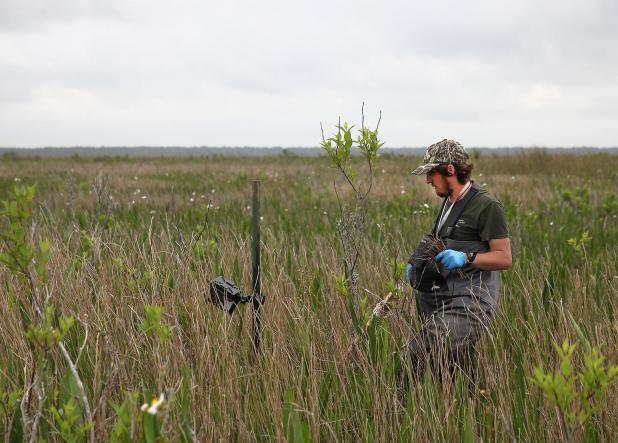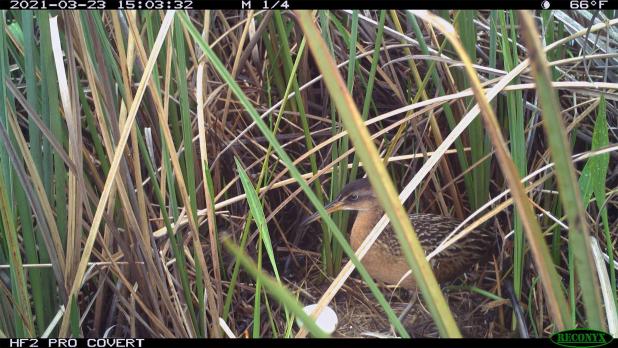
The Daily Review/John K. Flores
Alexandre L. Dopkin sets up a mottled duck nest site in the marsh.

Submitted Photo/Alexandre L. Dopkin
A clapper rail was one of the surprise perpetrators that depredated a mottled duck nest.
Photo courtesy of Alexandre L. Dopkin
John K. Flores: Study may shed light on decline in duck numbers
Alexandre Dopkin, an LSU graduate student working on his Master's in Renewable and Natural Resources, meticulously fashioned a bowl-shaped nest out of Jamaican saw grass with hopes that it resembled a mottled duck hen’s nest as much as humanly possible.
Afterwards, he fastened and secured it in the tall grass above the 20 centimeter waterline and set nine chicken eggs he dyed with tea bags inside. To add realism, he put a few duck down feathers over the eggs and then sprinkled the whole works with dog training duck scent.
The question is why go to so much trouble making an artificial nest? Over the past decade the western Gulf Coast’s mottled duck population has fallen precipitously. Mid-winter population estimates from 2000-2018 show Louisiana’s mottled duck numbers down 59 percent below its 70,000 target-mark, and Texas, 90% below its 35,000 mark. Combined, mottled duck numbers have plummeted to a third of what they were a decade ago.
Subsequently, harvest numbers declined as well in spite of the Louisiana Department of Wildlife and Fisheries lowering the daily bag limit from three to one in 2009.
With the decline, biologists have been looking for answers in a variety of ways that include looking at seasonal survival of adult females, movement of females using platform transmitter terminals, and geolocator bands.
Dopkin is currently working on a nest predation study. Essentially, nest success drives populations and in general depredation rates drive nest success, says the young biologist.
“The two hypothesis we are looking closely at are habitat loss and poor habitat quality, where quality of habitat is directly tied to nest depredation. If there are smaller and smaller patches of optimal habitat, ducks could be getting more congregated, which would leave them more vulnerable to predators in those areas,” Dopkin said.
One of the locations where Dopkin is doing fieldwork is White Lake Wetland Conservation Area. Considered prime mottled duck habitat, this coastal marsh encompasses 71,905 acres of assorted vegetation such as maiden cane, bull tongue, cattail, Jamaican saw grass, roseau cane and spikerush.
Other areas include Rockefeller Wildlife Refuge, and Lacassine National Wildlife Refuge and a host of private properties such as Sweet Lake Land & Oil Co. in Cameron Parish.
His research is being conducted on four distinct habitats consisting of chord grass meadows, cut grass marsh, terraces that combat wetland loss, and a conglomerate of upland habitats consisting of a merge between lightly grazed pastures, unattended fields, coastal prairie and fallow rice.
Dopkin said, “What we’re trying to learn from this study is what are the relative rates of predation in common mottled duck breeding habitats? What species of predators in those habitats are depredating nests? And, what predators are actually present on the landscape?”
Dopkin cautions that artificial nest survival is not the same as mottled duck nest survival. Moreover, just because 20% of cut grass marsh artificial nests get depredated does not mean 20% of “real” mottled duck nests in cut grass will be depredated.
Dopkin says what they are looking at is the rates between habitats. If for example 20% of artificial nests get depredated in cut grass habitat and 40 percent in upland habitat, forming a 2 to 1 ratio, they can reasonably expect a similar depredation ratio for real Mottled Duck nests across the two habitats.
To accomplish such a monumental task across a vast and diverse landscape, Dopkin is using artificial nests and utilizing game cameras to monitor nest activities along with regular site checks.
The use of cameras allow Dopkin and his team to see what types of predators are depredating nests, as well as learn about their relative abundance. But, in order to learn what kinds of predators are actually on the landscape, on pre-selected sites in each habitat, an array of 9 cameras are meticulously placed in a grid around the nest location.
It’s important to note that only half of the artificial nest sites receive cameras. However, one of the drawbacks to any camera study is the massive amounts of pictures that must be viewed and sorted through. Quite often upwards of 30,000 per site. The young biologist says he estimates he can go through 200 pictures of mostly grass per minute. But, hopes to amass a small army of volunteers to help him.
Some of the early perpetrators that raided nests were ones you’d expect in the coastal wetland communities Dopkin is studying. Mink, raccoons, water snakes and alligators were all captured by the field cameras across the four habitats. But, one of the early nests was depredated by an animal that turned out to be something that Dopkin didn’t expect.
In using it as a teachable moment, during one of his lab classes back at LSU, Dopkin gave his classmates five guesses each to guess what animal destroyed the nest. For incentive, a prize was offered to the lucky person who guessed right. None guessed correctly.
As it turns out, a Clapper Rail, a common bird along the Gulf Coast, was caught red handed on camera depredating an artificial mottled duck nest.
Dopkin’s mottled duck predator study includes two nesting seasons of field work and a half year of crunching data to record and present results. Hopefully, his findings will shed some light on the effects of mottled duck nest predation and its impact on the quality of nesting habitat in the western Gulf Coast.
